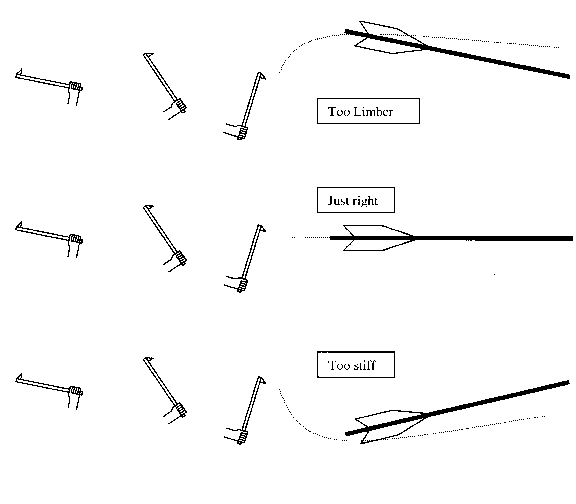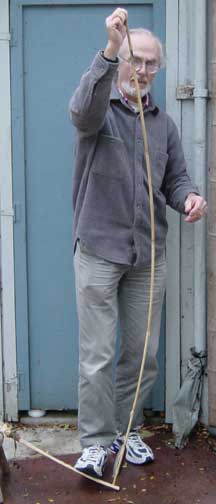
Introduction
How many of us made our first atlatl dart or spear shaft out of
some stiff, unyielding piece of wood or bamboo and concluded that
spear throwers weren't very effective because the back end of
the spear ALWAYS kicked down when we threw it? Enlightenment came
later. If you go today to an atlatl throw-in it should be pretty
obvious that the "kick-down" problem has been solved
and most of the darts or spears have nice straight trajectories.
The purposes of this article are to present a systematic procedure
for tuning atlatl darts so that they fly with the least up-and-down
perturbation and to provide a firm theoretical foundation for
why they behave the way they do.

Relationship With Archery
One common feature of shooting arrows and throwing atlatl darts
is the fact that the force is not applied in a straight line collinear
with the flight of the projectile. A bow string applies a force
in a fairly straight line aligned with the centerline of the bow
whereas the arrow has to bend around the handle of the bow. This
was especially the case with Robin Hood's yew longbow which had
a draw weight of 100 pounds and a handle diameter of 1 1/2 inches
(3.81 cm) [1]. The arrow had to snake around the handle. Consequently
archers are very aware that in order to achieve a clean trajectory
with no "wigwag" the arrow shafts must be "spined"
to the weight of their bow. People today who sell arrows have
charts which specify the appropriate arrow stiffness for a given
bow draw weight. There are also spine testers available for people
who still enjoy making wood arrows which are spined for a particular
bow weight. The same would be appropriate for atlatl darts.
Javelins used in tack and field events are an exception for several
reasons. The javelin thrower is able to exert a force in a fairly
straight line along the path of the javelin so the force tending
to deflect the xxx is small. The international organization which
governs track and field events specifies the dimensions, weight
and weight distribution of a competition javelin very rigorously
so there is no room for adjustment. Initially the rules allowed
javelins to have large diameter and a balance point (center of
gravity) behind center of force. This gave an aerodynamic trajectory
instead of a ballistic trajectory. In other words the javelin
sailed through the air like a glider instead of like a rock. The
result was greater distance with a good throw but the possibility
that a bad throw would swerve off into the crowd. The newer rules
insured that the javelin was more "rocklike" than "gliderlike".
Dart Tuning
We can employ an old archer's technique to adjust atlatl darts.
Archers are admonished not to depend on the arrow's fletching
(feathers) to insure an un-wavering trajectory. In order to tell
if your arrows are matched to your bow shoot them before apply
the fletching but after you apply the points. Get close to a target,
a few yards (meters) and shoot your fletchless arrows. Do they
go straight in or do they go in at an angle? For a right-handed
shooter, an arrow which is too stiff will have the back end deflected
to the right and conversely for an arrow which is too limber.
Arrows can be made less stiff by reducing their diameter. Typically
one buys shafts which have already been selected with a spine
or stiffness tester.
The same applies to an atlatl dart. Throw it before you apply
the feathers. Use the same throwing effort you normally use. If
the back end kicks down the dart is too stiff. If the back end
kicks up it is too limber. Enough said. The atlatlist has a couple
of choices for fixing a dart with an errant trajectory. If the
dart is too stiff get out your wood working tools and reduce the
diameter. If the dart is too flexible you can either shorten it
or make a new one out of stiffer or larger diameter material.
After it flys well you can add feathers to the back end. Figure
1 shows the three possible conditions.
How carefully do you need to tune your atlatl darts? It isn't
that critical. Remember, a very hard, fast throw should require
a fairly stiff dart whereas a slow gentle throw should require
a more flexible dart with a longer vibration period. You can test
your darts by throwing very hard, with a moderate effort and with
an easy toss. My observation has been that a well tuned dart works
well for a hard to moderate effort but almost always kicks down
for an easy toss.
Theory
A flexible shaft such as an arrow or atlatl dart will have a natural
vibration frequency analogous to a bell or a guitar string. The
period or amount of time needed for a complete cycle of vibration
is independent of the amplitude of the vibration. The trick in
tuning atlatl darts (or arrows) is to adjust their vibration period
to match, in some way, the time needed to complete the throw.
Because of the complicated nature of the throwing motion it is
impossible to give a simple relationship between vibration period
and time required to complete a throw. You simply use the theoretical
relationship between period and throwing time, test a featherless
dart and adjust its vibration period according to the way it flies.
Strictly speaking, a flexible shaft has a large number of different
vibration periods, depending on how it is excited and whether
or not it is held at one or both ends. The exact details are not
important. The only features we take advantage of are the facts
that the vibration period gets shorter if the shaft is shortened
and it gets longer if it is made thinner or additional weight
is added. Reducing the diameter of a wood shaft makes it lighter
and less stiff at the same time but the stiffness is reduced more
than the mass so the net effect is an increase in the vibration
period.
Extravagant claims have been made about the efficacy of making
the atlatl flexible so the vibration period of the atlatl matches
the vibration period of the dart. The claim is that this "resonance"
causes a "tremendous" increase in the dart's velocity.
Horsefeathers! When the dart and atlatl flex during the throw
energy is stored in the flexure the same way that energy is stored
in the bending of a bow limb. That"s where the similarity
ends. a bow is very cleverly designed to transfer its stored energy
to the arrow with high efficiency. [2] This is a doubly minor
effect in atlatl dart flexure. First, the amount of energy stored
in the dart flexure is very small compared with kinetic energy
of the dart (4.3 %). [3] Secondly, very little of the energy stored
in the dart flexure is available for increasing the dart velocity.
The simplest analogy is to think of a kid bouncing up and down
on a bicycle seat. All that up and down motion contributes absolutely
nothing to making the bicycle go forward. In order to test this
set your atatl on the ground, spur up and hold it in place with
your foot. Hold your favorite atlatl dart vertically, point up.
Place the butt end on the atlatl spur and flex the dart as much
as it would normally flex when being thrown. Now suddenly let
go and see how far it springs into the air. The vertical distance
it jumps is a measure of how much energy was added by dart flexure
to its forward motion. Hardly any height at all! Energy added
by dart flexure is a small fraction of a small fraction of the
total.
Flexure in the atlatl is a different story. Again, the added energy
is small, 6.7 %, compared with the total kinetic energy of the
dart [3] but it is available for increasing the dart velocity.
Conclusions
In order to have a good trajectory an altatl dart muse have sufficient
flexibility to compensate for the fact that the throwing force
is not applied in a straght line colinear with the dart. There
is a fairly wide range of flexibility which is acceptable.
[1] W.F. Paterson, "Mary Rose" - a second report,
Journal of the Society of Archer Antiquaries, 1981, pp 4-6
[2] C.N. Hickman, "Archery, the Technical Side", various
articles.
[3] Baugh, Richard, "Atlatl Dynamics", Lithic Technology,
Volume 23, no. 1, pp31-41.
These reference articles are available from the author at cost.
E-mail your comments to "Richard A. Baugh" at richardbaugh@att.net
We hope the information on the PrimitiveWays website is both instructional and enjoyable. Understand that no warranty or guarantee is included. We expect adults to act responsibly and children to be supervised by a responsible adult. If you use the information on this site to create your own projects or if you try techniques described on PrimitiveWays, behave in accordance with applicable laws, and think about the sustainability of natural resources. Using tools or techniques described on PrimitiveWays can be dangerous with exposure to heavy, sharp or pointed objects, fire, stone tools and hazards present in outdoor settings. Without proper care and caution, or if done incorrectly, there is a risk of property damage, personal injury or even death. So, be advised: Anyone using any information provided on the PrimitiveWays website assumes responsibility for using proper care and caution to protect property, the life, health and safety of himself or herself and all others. He or she expressly assumes all risk of harm or damage to all persons or property proximately caused by the use of this information.
© PrimitiveWays 2013